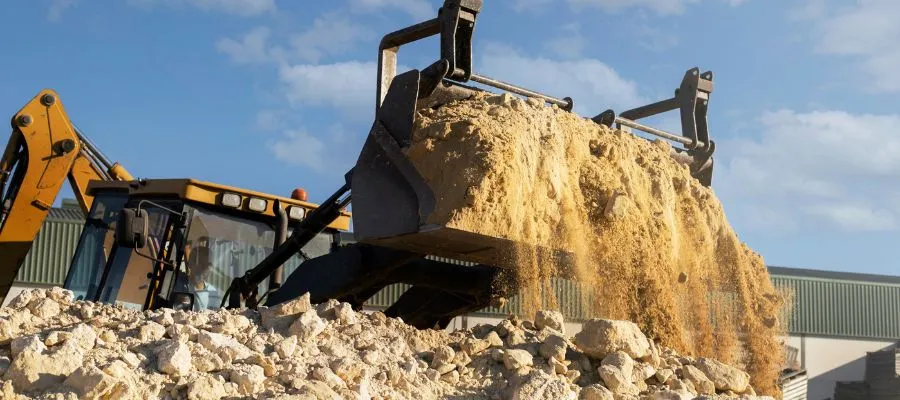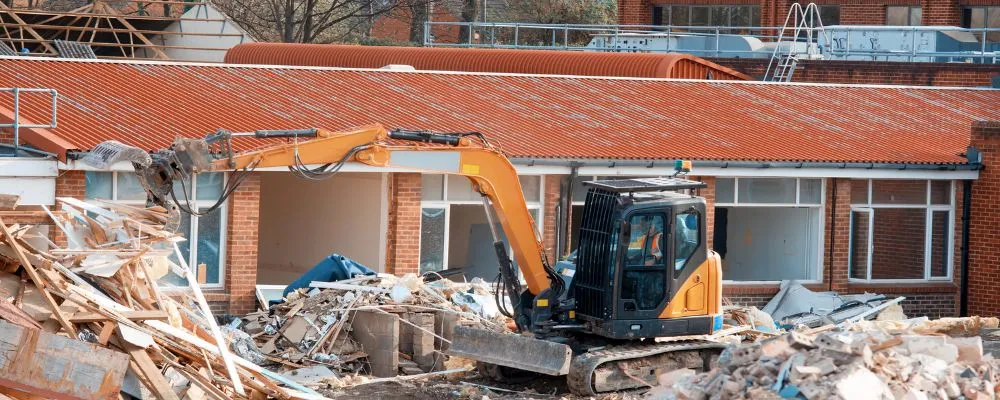Home demolition is an important part of a building’s lifecycle, and in India, where people are very different, it can happen in many different ways. Home demolition is an important part of changing the look of Indian cities and towns, from urban rebuilding projects to removing illegal buildings. In this blog, Brick & Bolt will detail how home demolition in India is done, including the reasons, legal systems, and government policies that govern this practice.
How Home Building Demolition Works?
When a building is demolished, it is taken apart piece by piece, usually to make room for new construction or reconstruction projects. In India, there are different ways to tear down a building, such as by hand, machine, or earthquake control. Each method has pros and cons depending on factors such as the structure’s size, location, and surrounding facilities.
Reasons Why Homes may be Destroyed in India

There are many reasons why homes are demolished in India, which include changing urban landscapes following the law, and public safety issues. Here are some of the main reasons why Indian homes may be torn down:
1. Urban Redevelopment :
As cities grow and become more modern, older buildings and neighbourhoods may be set aside for redevelopment to accommodate more people and improve city facilities. In this case, homes might be torn down to make room for new apartment buildings, shopping malls, or public spaces. Urban revitalisation projects aim to bring life back to cities, raise living standards, and boost the economy.
2. Illegal Construction:
India’s fast development has led to a lot of Illegal registeration & construction. Buildings are often put up without the right permits or violating building codes and rules. To police urban planning standards, protect public land, and stop more people from encroaching, local governments often order demolishing homes built without permission. Illegal building in cities harms city government, lowers safety standards, and can cause societal and environmental problems. Cancellation of the illegal registeration & construction can be done by court or government authorities, etc.
3. Environmental Concerns:
Homes in areas that are bad for the environment, like floodplains, coastal zones, or protected woods, may be told to be torn down as part of efforts to protect the environment. Building in these places can worsen environmental damage, destroy natural environments, and make people more likely to be hurt by natural disasters. Taking down homes in areas that are bad for the environment helps lower environmental risks, protect wildlife, and encourage sustainable land use.
4. Public Safety:
Buildings that are physically unsound, dangerous, or do not comply with safety rules put people who live there and people who live nearby at great risk. Building failures, fires, and other accidents show how important it is to take action against unsafe structures. To keep people safe, stop accidents, and follow building codes, the authorities may order these kinds of houses to be destroyed.
5. Road Widening and Infrastructure Projects:
Properties in the way of infrastructure development projects, like road widening, metro rail expansion, or airport building, often have to be bought and torn down. Homes that are in the way of these projects may have to be bought and torn down to make room for more infrastructure, better connections, and more transportation options. These kinds of projects are meant to make moving around and connecting cities easier, but they can also force people to move and cause social problems.
6. Urban Planning Initiatives:
Homes may need to be torn down as part of larger rebuilding plans for urban planning initiatives that aim to improve spatial organisation, rationalise land use, or deal with urban blight. Governments and urban development officials establish zoning rules, land use plans, and development control norms to control urban growth and maximise resource use. In urban planning, demolition is used to make cities better places to live, work, and play for everyone.
Steps Involved in Home Demolition in India

In India, home demolition is done in a series of steps, including legal, technical, and practical considerations. The exact steps may be different based on local laws and the type of demolition project, but the list below gives you a good idea of what usually happens when a house is torn down:
1. Issuance of Demolition Notice:
The process usually starts with the local or government body issuing a demolition notice. This notice officially tells the property owner that the building will be torn down and gives specifics about the legal grounds, reasons for the action, and due date for compliance. The notice is a legal document that starts the demolition process and allows the property owner to react or appeal the decision if necessary.
2. Evaluation of the Structure:
Before a building is torn down, it is carefully evaluated by trained structural engineers or demolition experts. This report looks at the building’s state, including its structural soundness, the materials used, possible dangers, and how it affects the environment. What the assessment shows helps make a plan for tearing down the building and figures out the best ways to do things during the removal process.
3. Getting Permits for Demolition:
Before starting demolition work, property owners or their authorised agents must get all the permits and clearances they need from the right authorities. These permits may include approvals from the local planning or municipal company, environmental clearances, and any other regulatory approvals required by the area’s laws and rules. By following the rules for getting a permit, you can be sure that removal work is done legally and properly, lowering the chances of illegal or unauthorised demolition.
4. Execution of Demolition:
Once all the necessary permits and approvals are gathered, the accepted demolition plan is followed during the demolition process. Demolition can be done in many ways, depending on the type of building and the site conditions. These include taking it apart by hand, using heavy machinery to do it mechanically, or controlling the implosion of large structures. Safety measures are put in place to keep workers, bystanders, and nearby properties as safe as possible, such as blocking off the site, controlling entry, and putting dust suppression measures in place.
5. Waste Management and Site Clearance:
Once the demolition is done, the area is cleaned of any trash, rubble, and other waste made during the process. The right waste management techniques separate recyclable materials, like concrete, metal, and wood, for reuse or recycling. Non-recyclable trash is thrown away in a way that follows environmental laws. As much as possible, site cleanup tasks may also include levelling surfaces and grading the land to make it look like it did before the demolition.
6. Post-Demolition Documentation:
Once the demolition work is done, all the related paperwork and records are collected and kept for future use to ensure the rules are followed. This includes demolition permits, engineering reports, waste disposal receipts, and any other relevant paperwork. These records show that legal requirements were met, and authorities or interested parties may ask for them during inspections, audits, or dispute settlement processes.
7. Rehabilitation and Redevelopment:
If the demolition is part of a larger redevelopment or rehabilitation project, the next steps may include buying land, moving people who will be affected, and implementing redevelopment plans in a way that follows all laws and rules. The goal of redevelopment projects is to make the best use of land, improve living conditions, and improve cities’ facilities while also considering social, economic, and environmental factors.
The Legal Framework for Home Demolition in India:
The laws in India that rule home demolition are made up of statutes, regulations, and court decisions from the national, state, and local levels. These parts of the law spell out the rights and duties of property owners, the government, and others who have a stake in the removal process. Here is a summary of the main parts of India’s laws that govern demolishing homes:
1. Municipal Laws: Building codes, land use rules, and urban planning standards are largely controlled and enforced by local municipal groups such as Municipal Corporations and Municipal Councils. Municipal laws give these groups the power to order the destruction of buildings that don’t follow building codes, pose a threat to public safety, or get in the way of plans for urban growth.
2. Development Control Regulations: Created by urban development authorities and planning agencies, development control regulations spell out the allowed uses of land, building setbacks, floor space indices, and other rules that guide building activities in certain zones. If you break these rules by doing things like building without permission or not following the accepted building plans, the authorities may send you a demolition notice.
3. Building Bye-Laws: Local governments pass building bylaws that align with national building codes and standards. These laws spell out the technical requirements, construction rules, and safety standards that apply to building construction and demolition. Property owners and investors who are building or tearing down homes must follow building bylaws. This protects the structure, keeps people safe, and protects the environment.
4. Laws on Land Acquisition: When homes need to be torn down for big building projects, urban renewal programs, or public works plans, land acquisition laws make it easier for the government to buy land and properties for public use. These laws spell out how to take over land, figure out who should get paid, and help people who have been affected move on with their lives. They protect the rights and interests of property owners while also serving the general interest.
5. Environmental Regulations: When people tear down homes, they have to follow rules meant to protect the environment, reduce waste, and conserve natural resources. If a demolition project will affect ecologically sensitive areas, water bodies, or air quality, it may need to undergo an environmental impact study to ensure it follows environmental rules and takes the right steps to protect the environment.
6. Judicial Precedents: Court decisions and legal precedents set by courts are very important in understanding and applying the laws in India that govern demolishing homes. Courts decide disagreements about demolition orders, property rights, settlement claims, and mistakes in the process. They do this by making the law clear, holding people accountable, and giving people who have been wronged ways to get justice.
7. Due Process and Procedural Safeguards: In India, the law for tearing down homes stresses due process, procedural fairness, and following natural justice principles to protect property owners’ rights and make clear decisions. Notices of demolition must be given in writing, including a reason for the demolition and a chance for those affected to be heard by the right officials.
Government Policies and Programs Related to Home Demolition in India:
India’s government has policies and programs for tearing down homes. These cover many projects that aim to solve different urban development problems, ensure rules are followed, and encourage sustainable and inclusive development. Here are some of India’s most important laws and plans for tearing down homes:
1. Slum Rehabilitation Schemes:
Many Indian towns have problems with the growth of slums, which are informal settlements with bad housing, bad infrastructure, and social and economic problems. Governments at the state and local levels run slum rehabilitation programs that try to improve people’s lives by giving them better housing choices, basic amenities, and social and economic support. As part of these plans, illegal or falling apart buildings are often torn down and the people who live in them moved into new, legal housing projects that were built through public-private partnerships or government-funded programs.
2. Urban Renewal Initiatives:
Urban renewal initiatives aim to improve failing urban areas, bring life back to run-down neighbourhoods, and encourage long-term urban growth. Some of these projects may involve tearing down and rebuilding old or unused buildings, waste sites, or areas that are falling apart because of urban decay. Government agencies, urban development authorities, and private developers work together on urban renewal projects that include mixed-use development, green spaces, heritage preservation, and infrastructure upgrades. These projects make cities better places to live and do business.
3. Disaster Management Plans:
Because India is prone to natural disasters like earthquakes, floods, cyclones, and landslides, disaster management plans include ways to eliminate dangerous buildings that could put people in danger during emergencies. These plans explain how to check the stability of a building, decide which demolition tasks are most important, and coordinate response efforts with the right people, such as community groups, government agencies, and crisis management authorities. After a disaster, demolition activities are mostly about getting rid of debris, fixing up important infrastructure, and making it easier for people to get back on their feet and start rebuilding in damaged areas.
4. Encroachment Clearance Drives:
Municipal governments run encroachment clearance drives to regain public land, waterways, and other areas that people, companies, or informal settlements have moved into without permission. As part of these drives, encroached areas are marked, eviction notices are sent out, and illegal structures are torn down to make public places safe again. The goal of encroachment clearance drives is to protect public property, ease traffic, and reduce traffic jams in cities, all while upholding the law and ensuring everyone has equal access to city services.
5. Heritage Conservation and Urban Planning:
Government policies that support heritage conservation and urban planning make it a priority to protect historic buildings, cultural sites, and architectural heritage while also meeting the needs of modern growth. Heritage protection laws and demolition rules say that heritage buildings must be kept up. Before granting demolition permits for historically important buildings, these buildings must be carefully evaluated, heritage impact studies must be done, and the public must be consulted. To find a balance between the need for preservation and the need for urban growth, urban planning frameworks include historical conservation principles in land use planning, zoning rules, and development control norms.
6. Programs for Affordable Housing:
These programs, which are backed by the government, aim to fix the lack of affordable housing, make housing more accessible to low-income families, and resolve housing issues. As part of these programs, slums, run-down buildings, or illegal settlements may be torn down and replaced with cheap housing units built through public-private partnerships, subsidised housing schemes, or housing cooperatives. To ensure that marginalised groups get the help they need from housing programs, affordable housing programs put social inclusion, neighbourhood participation, and affordability criteria at the top of their lists.
In conclusion, home demolition in India is complicated and has many processes. It is affected by things like population growth, laws, and government policies. Understanding the steps, reasons, and rules for demolishing homes can help everyone get through this tricky area more easily and legally, which promotes fair community results and long-term urban growth. More and more people are moving to cities in India, which means that effective and fair ways to demolish homes are becoming increasingly important for shaping the future of the built environment.

